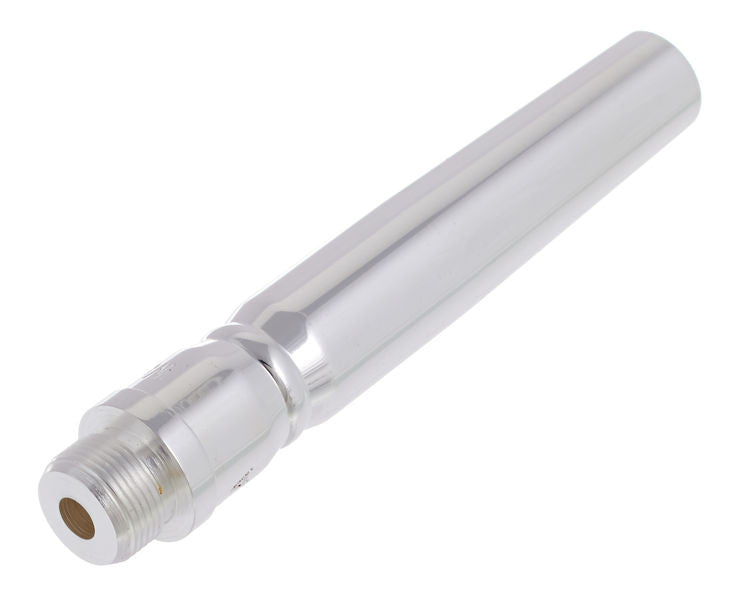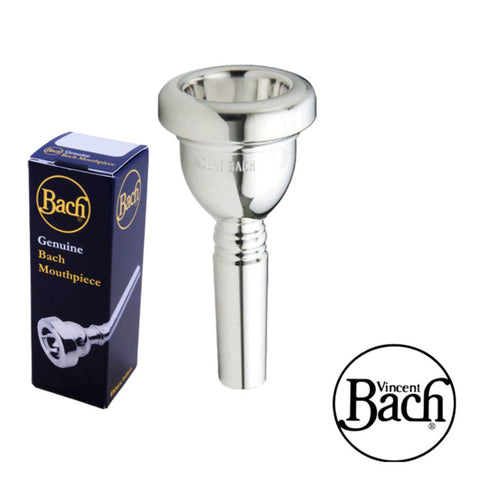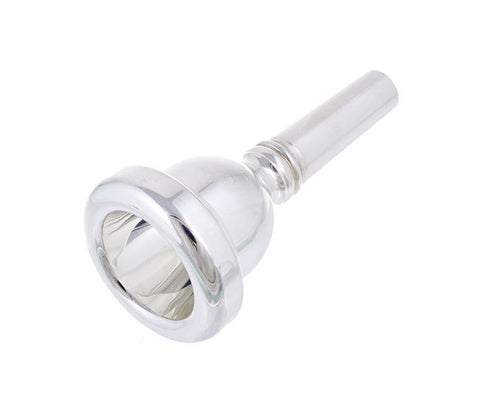Warburton Trumpet Mouthpiece Backbore
$49.99 $80.00
Item Details
Save $$$ on Warburton backbores. Limited to stock on hand, choose from the drop-down menu.
These backbores are part of a two piece component mouthpiece system made by Terry Warburton in Florida. These backbores thread into a Warburton top that consists of the cup and rim. Mr. Warburton grew up playing trumpet, learned mouthpiece making in Canada, then worked under Bob Giardinelli in the 1970's as he perfected his machining prowess. Terry is considered one of the leading mouthpiece makers of our generation.
The Warburton system lets you choose a combination of rim diameter, cup style and depth, with a backbore to best balance your sound and resistance. This flexibility means you can have the most efficient mouthpiece with which to perform in any given playing situation.
The two-piece system consists of fully interchangeable top sections and backbore sections. Due to the many demands placed upon the modern brass player, the variety of Warburton cup designs are able to produce the most desired sound in any playing idiom.
The backbore sizes compliment the cup designs and further assist in the refinement and fine-tuning of the sound. Consideration has been given even to the placement of the backbore into the receiver (amount of gap).
The Warburton system allows the player the opportunity to personally balance their equipment. This can be accomplished without the necessity of traveling to a mouthpiece maker or waiting for a mail-order custom made piece that often does not work and cannot be exchanged.
What does the backbore do?
1. Regulates resistance
2. Helps achieve your desired sound quality
Fine tuning the resistance with a backbore relates to your own physiology (air capacity, coordination of chest, back, and abdominal muscles, elasticity of the lips) and your personal musical goals (maximum required volume, tone color, broadness of sound, intensity, and technical efficiency). Each and every backbore that you play-test will score slightly differently in each of these categories. Your own trumpet and choice of cup style will set the parameters for this balancing act.
We would all agree that there are as many sounds as there are musicians. In my conversations over the years with seasoned trumpet players, I hear an often recurring theme: "No matter what the mouthpiece, the player will find a way back to his own sound if given enough time."
Where the Warburton System becomes so effective and valuable is in this area of concern. Rather than having to make physical adaptations to achieve your musical goals, your equipment is "customized" to enhance your most natural approach to trumpet playing. The result is the elimination of tensions which serve to work against efficiency and progress.
-Terry Warburton
Bore Size
#27 is the standard bore size of Warburton trumpet mouthpieces. The designation corresponds to standard drill bit sizes, with the size increasing as the number decreases. #27 (.144") has long been the standard of the industry and has proven to be a good choice for most players, but there are cases in which opening the bore size does make sense,
If you are experiencing a "bottle-neck" or stuffy feeling, it is necessary to first consider other factors which may be the root cause such as:
- Rim diameter too small
- Wrong backbore choice for you
- Wrong cup depth or style for you
- Too large of a gap
If you have fine-tuned to your preferred resistance via the backbore system only to result in a sound which is just too dark or unfocused, a larger bore size may be in order. Opening the bore size will increase the maximum flow of air per second that the mouthpiece can accommodate without significantly changing its characteristic sound. If you choose to do this, have it done on a lathe by a qualified repairman or at the Warburton factory. You will need to alter both top and backbore. Remember, there is some risk involved, so never open the bore size by more than one step at a time.
Available Sizes
1, 2, 3 - Our tightest commercial sounding backbores. These models have a concentrated and intense sound. The #3 is the most popular of this series. If offers a bright, projecting sound that is great for lead players and outdoor work.
4, 5, 6 - Tight to medium. With progressively less resistance, these models produce a bright and very projecting tone. The #5 is by far our most popular with strong lead players.
Q Backbore - New in 2004, the Q is our most aggressive backbore, preferred by lead players who also need to maintain dominance in the middle register without spreading or over-loosening their chops.
Qm Backbore - New in 2008, the Qm is a slight modification to the Q backbore. A modified taper in the venturi section slightly compresses the air column to increase velocity before releasing the air into the main body of the backbore. The result - An exciting commercial sound with an intense center.
NY Backbore - This backbore was inspired by the sound of the old Giardinelli #3 (default) backbore made popular by Maynard and others in the '70's. The New York sound was broad, bright, and acoustically loud - which are also the qualities of this backbore. Resistance is just a bit tighter than our #5.
KT Backbore - Added to the line in mid 1987, this backbore appeals to commercial/lead players and is characterized by its projection and secure slotting of notes above high C. The comparative resistance falls in the 4, 5, 6 series.
7, 8, 9 - Medium large sizes. The #7 has been the best selling model because it provides a good balance of sound quality acceptable in the orchestra as well as the concert band. Models #8 and #9 are very well received by the orchestra player who appreciates the increased volume of sound with less resistance.
10, 11, 12 - Very large "Symphonic" sizes. These models have very little resistance and offer the strong player the potential for the ultimate in full, rich sound.
Schilke Piccolo Trumpet - These "S" backbores were designed to enhance response on the Schilke P5-4 piccolo trumpet. They are identical to our standard cornet backbores, but have a narrower exterior taper. The most popular models are the S10 and S10-star.
The Star Backbore
Each standard backbore has a cylindrical section at the top where only the #27 reamer has passed. This cylinder is of varying lengths depending on the overall size of the backbore. (#1 has the longest cylinder, #9-12 the shortest). On Star backbores, this section is altered to be conical (tapered). Players report the following general characteristics:
|
Standard |
Star |
|
Slots on each pitch are more defined with tighter center. |
Slots are roomier - easier to lip pitch up or down without changing timbre or chipping attacks. |
|
Notes will "pop" (sound like du tongue) when slurring rapidly up a chromatic scale. |
Notes tend to smoothly glide together on chromatic scale. |
|
Broadness of sound is limited in order to favor projection. |
Produces broader, more blending sound, less projection. |
The Q Backbore
Highly efficient - The player's buzz is amplified to a vibrant sound, even in the mid and low registers. This makes it possible for lead players to remain authoritative in these registers without having to overly-loosen their chops. This pays off big in the endurance department.
Resistance - similar to our #4 backbore, but the increased quantity of sound requires less physical drive to sustain dominance. An entirely new reamer was created to make the Q backbore so more specific comparisons aren't possible.
Slightly lower pitch center - The Q is .050" longer in length overall than our standard backbores. This added a unique type of resistance resulting in firmer "walls" around the slots. If you are playing at extreme volumes, this type of security can make the difference between a guarded performance and a boldly dynamic one. Most players who use the Q have found that their tuning slides can come in as much as a quarter inch, resulting in a more consistent timbre and better intonation.
B Q - This popular version of the Q has a shank diameter .005" larger. This added diameter can re-establish a functional gap distance in trumpets with worn receivers and where the mouthpiece receiver has been soldered to the lead pipe improperly. If there is a noticeable problem with "LOCKING-IN" of the upper partials, the "B" backbore will very often rectify the problem.
- "B" is 0.005 inch larger than standard and is most often used to correct the typical gap problems. (increases the GAP by 0.1 inches)
What is your best selling Warburton mouthpiece size?
Terry Warburton writes:
Year after year the 4M is the best selling top. The #4 diameter (.660") appeals to the greatest number of trumpet players, but diameters 3 and 5 aren't far behind. The M cup is popular because of its versatility and well balanced blend of highs, mids, and lows. The best selling backbore has consistently been #7. This medium-large backbore produces full bodied sound, yet is compact enough not to fail you in the upper register.
Believe it or not, this is a frequently asked question but is founded mainly in curiosity. Don't be fooled into thinking that you will be more normal if you play a 4M/7. Choosing a Warburton mouthpiece should be based upon play-testing combinations in a logical manner. And come to think, have you ever seen a family with 2.2 kids?
| Other Popular Combinations | ||
| Playing Style | Top | Backbore |
| Orchestral Bb | 3MD | 9* |
| Band, Recital | 4MC | 8* |
| Commercial Lead | 5S | KT |
| Schilke Style Piccolo | 3SV, 4SV, 5SV, 5S | 10 |
| Selmer Style Piccolo | 5SV | 8 |
How to Choose
After choosing a comfortable diameter and style of Warburton top, try one diameter size up and down to confirm the diameter selection.
Select an intermediate size backbore (6 or 7). Note that at this point this backbore is for test purposes and is to be used to settle in on diameter and cup shape. Other backbores will be tested later to balance the sound.
Play various cup models of the chosen diameter according to performance needs and desired sound:
| Desired Sound | Try these cups |
| Studio lead | ESV, ES, S, SV, or M |
| Piccolo sound | S, SV, or M |
| Brass quintet | M, MC, or MD |
| Orchestral | MC, MD, D, or XD |
Repeat the same musical passage, such as a scale, and compare the changes in timbre and settle in on which sounds the best. Remember, compare sound, not technique.
Using the cup selected, try a tighter backbore (one with a lower number), then one that is more open (one with a higher number). There will be a noticeable difference in the way it blows as well as in the way it sounds. This will give you a good idea of which direction to move to find a backbore that will suit your needs. While the Star (*) series backbores may feel more free blowing, depending on the player, these backbores may not focus as well as the standard series. This will be a personal choice.
Once a combination has been selected, go back and confirm the cup selection and then play the original mouthpiece as a comparison. You and your listener will hear a difference and you will feel a difference.
Remember that different styles of music may require different equipment to achieve the appropriate sound for the job. So, change equipment to get the optimum sound, not the method of playing.
My Warburton top and backbore are stuck together. What do I do?
Don't even think about pliers!
In almost every case an aggressive "whack" will do the trick. Grasp the mouthpiece firmly with the rim facing up. Use a rawhide mallet or wooden clave to strike the top surface of the rim. If these are not handy, use a scrap piece of wood or a wooden hammer handle. The wood cannot dent the solid brass, so be sure and strike hard. In most cases the components will now unscrew easily by hand, but may occasionally need some additional gripping power. The best I have found for this task are rubber tourniquet strips. Lid grippers are also okay. We have not found any wax or grease than can guarantee to prevent your parts from sticking together. The best way to avoid a problem is to unscrew them regularly.










